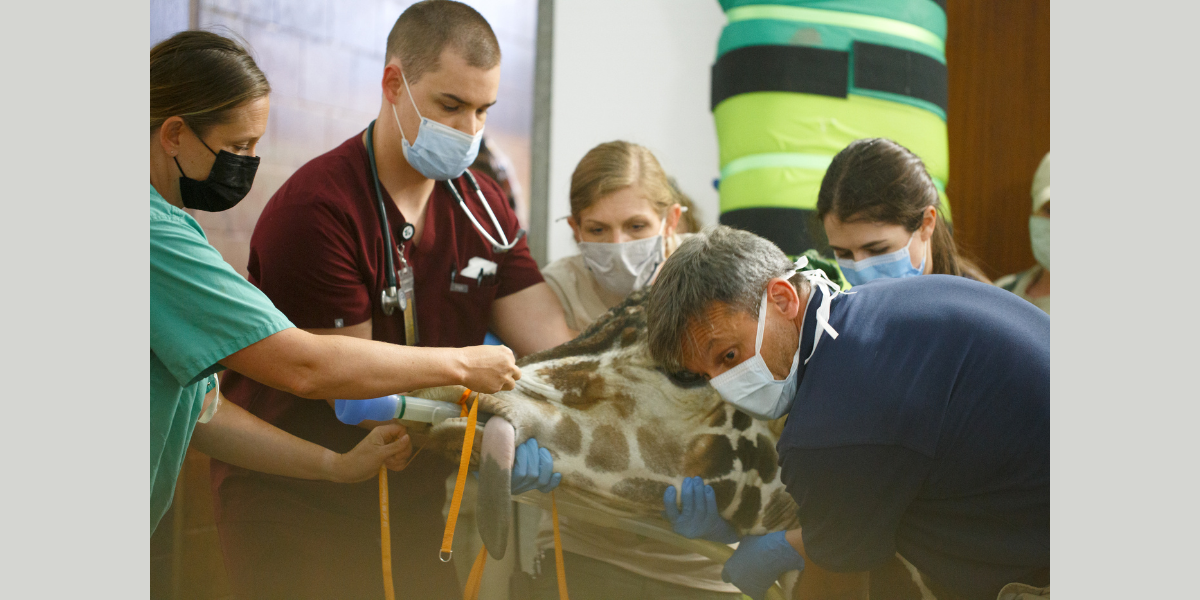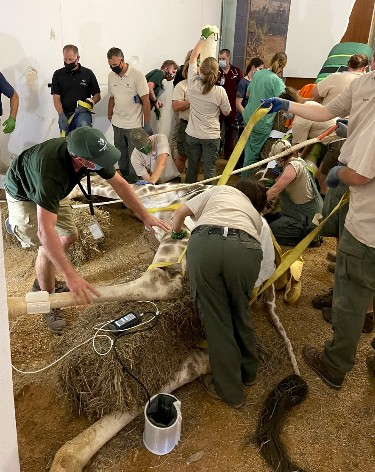Tall teamwork
It takes a global team of clinicians to anesthetize and treat the world’s tallest animal

It takes a global team of clinicians to anesthetize and treat the world’s tallest animal
Veterinary professionals from around the world, including the UMN College of Veterinary Medicine, assembled to treat the foot injury of Skeeter, a 13-year-old giraffe living at the Como Zoo & Conservatory in St. Paul. Photo courtesy of Como Zoo.
When a dart loaded with anesthesia exited the dart rifle and stuck Skeeter, the Como Zoo’s only male giraffe, in his rump, Andrea Persson, RVT, rushed to hit the lights.
Persson, a veterinary technician at Como Zoo, and a small group of her colleagues fell silent behind the window that peered into the oversized horse stall that an international team of animal experts had meticulously lined with styrofoam. They waited for 20 minutes. Nothing happened. They tried again.
This time, Skeeter walked to the corner of the stall. He stood still for a few minutes before his interminable legs bent. His head, atop his equally long neck, sailed backward until the 2,000-pound giraffe had met the ground. It was go-time.

“As soon as he was down, everyone rushed in and got to work,” Persson says.
What happened next took weeks of preparation, consultation, and planning. In the summer of 2021, Skeeter had fractured a bone in his hoof, rendering one of his four legs virtually unusable.
“There aren’t a lot of treatment options for the fracture he had and anesthetizing a giraffe is risky,” Persson says.
Dr. Fausto Bellezzo, an assistant professor in the University of Minnesota (UMN) Department of Veterinary Population Medicine (VPM) and resident veterinarian for Como Zoo who led Skeeter’s team, regularly performs procedures on horses that require anesthesia.
“I’m used to big animals, but nothing that tall,” says Bellezzo, who immediately crowd-sourced information from his colleagues at the Minnesota Zoo, San Diego Zoo, Cheyenne Mountain Zoo, and Columbus Zoo.
One risk Bellezzo worried about was Skeeter fracturing his lengthy limbs or neck –– a risk particularly concerning when anesthetizing giraffes. But his primary concern was ventilation. Without a good supply of oxygen, Skeeter’s muscles would cramp and prevent the giraffe from being able to stand up after the procedure. Bellezzo was at a loss about what to do next, but he tapped into the network and consulted a veterinarian he knew would have the answers.
Dr. Jeff Zuba, a recently retired senior veterinarian at the San Diego Zoo, spent his career anesthetizing mega vertebrates including rhinoceroses, elephants, hippopotamuses –– and giraffes. He even developed a special ventilator for the gargantuan animals that have historically had a hard time getting adequate oxygen during surgery.
“He took away that fear, and once that fear was gone, we reached out to everyone who has experience with giraffes,” Bellezzo says.
Minnesota Zoo veterinarians were able to come out to assist Belezzo and his team, bringing along Zuba’s mega vertebrate demand ventilator –– which is nicknamed “the Zubinator” to safely ventilate Skeeter.
Another vital expert was Steve Foxworth, a farrier from Northern Colorado who specializes in equine lameness. He knew exactly how to fit Skeeter with a splint –– called a shoe –– that would allow his fracture to heal. In fact, he invented it.
The polyurethane splint works like splinting two fingers together in humans when one of the fingers is fractured. The splint provides support and disables the finger’s ability to move and bend independently. The same had to be done for Skeeter’s hoof, which, like all giraffes, had two sides that moved semi-independently. The fractured side had to be bound to the healthy side until it healed.
When Bellezzo, Persson, and their team of zookeepers and veterinarians entered the stall as soon as Skeeter went down, everyone had a role to play.
One person stuffed cotton into his ears. Others massaged his neck and stretched his legs. A team of anesthetists from the UMN put a large tube into Skeeter’s trachea and secured the Zubinator. The zookeepers directed the team on how to position his trunk, legs, and neck and Persson put two IVs into his jugular.
“There were a lot of details that needed to be assigned beforehand, but it came together perfectly. We thought of even insignificant things like who would put his earplugs in,” Persson says.

When the custom splint was secured in place, the zookeepers moved Skeeter’s body into the best position to help him stand once he was given the reversal. Only two team members, Bellezzo and Steve Foxworth, stayed in the stall when the giraffe began to wake up, guiding his head as he moved to stand up.
Today, Skeeter is living life to the fullest and celebrated his 13th birthday on July 7, 2022. In the year since his initial treatment, his care team successfully anesthetized him one other time to remove his shoes and treat what remained of his fracture with stem cells. It's a great outcome but is one no single clinician can take credit for.
“I was in charge, but I was by no means solely responsible,” Bellezzo says. “It takes a village.”